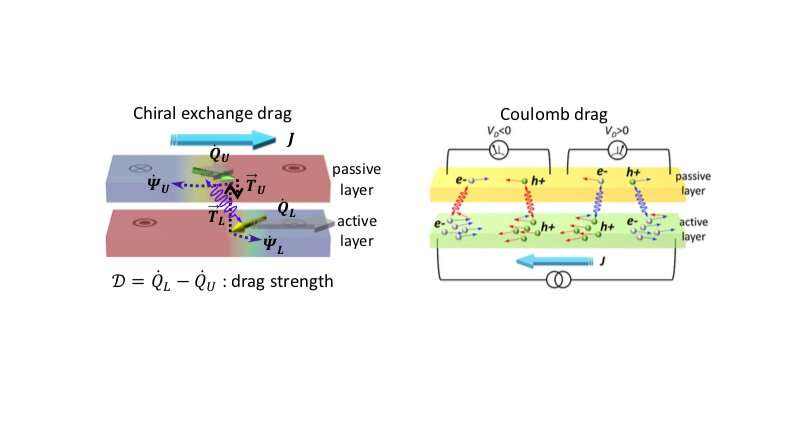
A quasiparticle is a disturbance or excitation (e.g. spin waves, bubbles, etc.) that behaves as a particle and could therefore be regarded as one. Long-range interactions between quasiparticles can give rise to a ‘drag,’ which affects the fundamental properties of many systems in condensed matter physics.
This drag generally involves an exchange of linear momentum between quasiparticles, which strongly influences their transport properties. Researchers at IBM and the Max Planck Institute have carried out a study investigating this drag and chirality oscillations in synthetic antiferromagnets. In their paper, which was recently published in Nature Physics, they defined a new type of drag that involves the exchange of angular momentum between two current-driven magnetic domain walls.
“In recent years, I have worked on the interplay of spin current with chiral magnetic domain wall whose chirality is set by Dzyaloshinskii-Moriya interaction at interface,” See-Hun Yang, an IBM researcher who carried out the study, told Phys.org.
In 2013, Yang and his colleagues showed that chiral domain walls can be efficiently moved by a relativistic spin-orbit interaction induced spin current, referred to as spin-orbit torque. Around the same time, this observation was also reported by a group of researchers at MIT.
A few years later, Yang and his colleagues observed that coupled chiral domain walls can move at much higher velocity (~ 1 km/s) by current, due to a powerful exchange coupling torque when they are antiferromagnetically coupled. Yang developed a model that could help to better understand these observations and also discovered a new powerful torque called exchange coupling torque.
“During the data fitting with my model, I spotted a strange anomaly phase in a certain parameter space in domain wall velocity versus applied longitudinal field curves that shows a high asymmetry,” Yang explained. “I observed that a coupled domain wall gets dramatically slowed down at negative fields when the exchange coupling is relatively weak. For instance, my model showed that coupled domain velocity collapses from 500 m/s down to zero by application of merely -50 mT field.”
Yang found that the dramatic reduction in velocity observed in his research was due to oscillation of coupled domain walls displacement. Most interestingly, he learned that domain wall magnetizations oscillate/precess in a way that is synchronously correlated with domain walls displacement.
“To observe this interesting novel phase, we started a new experiment by preparing devices formed from weakly coupled synthetic antiferromagnetic (SAF) films, which could be achieved by growing thinner Cobalt layers sandwiching Ruthenium spacer in SAF,” Yang said. “Note that Ruderman-Kittel-Kasuya-Yosida (RKKY) interaction induces exchange coupling between Cobalt layers across Ruthenium spacer layer.”
The strength and sign of RKKY interactions are sensitively dependent on the thickness of a Ruthenium layer. Since RKKY interactions are only sensitive to interfaces, given a particular Ruthenium layer thickness, the exchange coupling strength can be tuned further by thinning down the Cobalt layer below one monolayer.
“In our experiment, we luckily and immediately reproduced the highly asymmetric domain wall velocity-longitudinal field curve and dramatic collapse of domain wall velocity predicted by my model, which I was very excited about at the time,” Yang said. “However, it took more than a year for me to fully understand the physical mechanism of this strange phase.”
In an attempt to better understand his prior observations, Yang spent a long time looking into his model and rewriting coupled equations of motion in several different ways. He finally discovered that the strange dynamic phase he had observed was related to a kind of drag called chiral exchange drag (CED).
“When a current flows into two coupled sub-layers, different spin-orbit torques are exerted on chiral domain walls since the environment for each domain wall is not identical,” Yang explained. “Consequently, one chiral domain wall moves faster than the other. However, since their positions are tightly bound to each other, a faster domain wall “drags” a slower one. This means that the coupled domain walls move at the intermediate velocity, that is, average velocity weighted by their magnetizations.”
